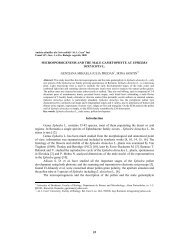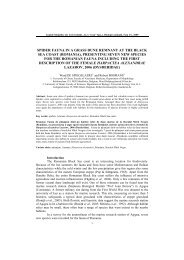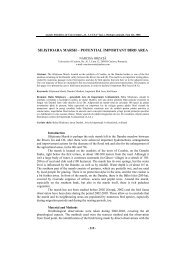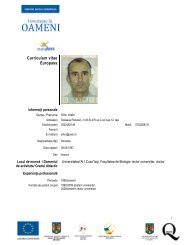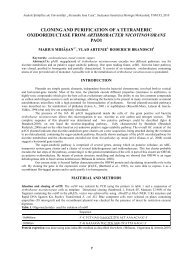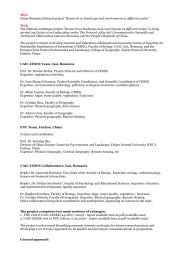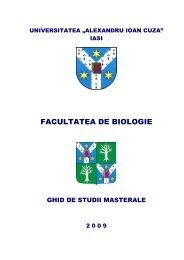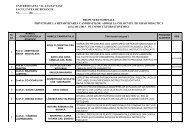Analele ştiinţifice ale Universităţii “Al - Facultatea de Biologie
Analele ştiinţifice ale Universităţii “Al - Facultatea de Biologie
Analele ştiinţifice ale Universităţii “Al - Facultatea de Biologie
Create successful ePaper yourself
Turn your PDF publications into a flip-book with our unique Google optimized e-Paper software.
The petiole. In cross section, the petiole has a semieliptic-crescent profile, with<br />
concave adaxial face. Epi<strong>de</strong>rmis displays isodiametric cells, with the external wall thicker<br />
than the others and covered by a fine stripped cuticle; here and there, short unicellular or<br />
bicellular protective hairs are present. In the fundamental meatic parenchyma,<br />
collenchymatised in hypo<strong>de</strong>rmic position, phloemic-xylemic bundles of collateral type are<br />
present, of various number and position: numerous and closed one to another, disposed on a<br />
curved sheath and 1-2 far away from the others (M. bihariense); 3, with the middle one<br />
bigger than the others (M. saxosum) (Fig. 18); a wi<strong>de</strong> median arch with numerous bundles<br />
separated by uni- or multilayered parenchymatic rays and two lateral bundles (M.<br />
sylvaticum).<br />
The foliar limb. In front si<strong>de</strong> view, the epi<strong>de</strong>rmis displays cells of irregular shape,<br />
with strongly curved lateral walls; stomata of anomocytic type have various location: in<br />
both epi<strong>de</strong>rmis, so the foliar limb is amfistomatic (M. arvense and M. sylvaticum) or only in<br />
the lower epi<strong>de</strong>rmis, so the foliar limb is hypostomatic (M. bihariense, M. cristatum and M.<br />
saxosum). M. bihariense presents, in the lower epi<strong>de</strong>rmis, very big nectariferous extrafloral<br />
glands, located in <strong>de</strong>ep excavations; those glands bear numerous, radiary elongated,<br />
secretory cells which form a continuous sheath beneath the basal part.<br />
Both epi<strong>de</strong>rmis displays secretory and protective hairs, with different structure and<br />
position, as follows:<br />
- M. arvense: numerous protective hairs, mostly unicellular, but bi- or multicellular,<br />
too, bearing a basal cell of circular profile; they are longer at the lower part of the<br />
foliar limb and the point is flexed; very short protective hairs with thick wall and<br />
obtuse point, at the edge of the foliar limb; the secretory hairs are shorter, sessile,<br />
with bicellular gland in cross section;<br />
- M. bihariense: very short protective hairs, unicellular, rarely bicellular,<br />
aculeiform, oblique, narrow-pointed and with very thick walls; rare, short<br />
secretory hairs, with bicellular gland in cross section;<br />
- M. cristatum: numerous uni- bi- or multicellular protective hairs in both epi<strong>de</strong>rmis;<br />
rare multicellular secretory hairs;<br />
- M. saxosum: numerous short protective hairs, unicellular and mostly bicellular,<br />
located in the upper epi<strong>de</strong>rmis; numerous, short secretory hairs, with bicellular<br />
gland in cross section, more frequent in the lower epi<strong>de</strong>rmis;<br />
- M. sylvaticum: short, unicellular protective hairs, narrow-pointed, more numerous<br />
in the upper epi<strong>de</strong>rmis; multicellular secretory hairs, more frequent in the lower<br />
epi<strong>de</strong>rmis.<br />
In cross section of the foliar limb, the middle vein is very prominent at the abaxial<br />
face and consists of fundamental parenchyma and a vascular bundle or arch of condutive<br />
elements in M. bihariense (Fig. 19).<br />
The mesophyll could be: 1) weak differentiated in one-layered palisa<strong>de</strong> tissue with<br />
wi<strong>de</strong> and short cells and multilayered lacunary tissue, so the foliar limb has a bifacialheterofacial<br />
structure (M. arvense, M. cristatum and M. saxosum); the cells of the palisa<strong>de</strong><br />
tissue may have H form in M. saxosum and M. arvense (Fig. 20); 2) homogenous, of<br />
lacunary type, with the hypo<strong>de</strong>rmic adaxial layer bearing high and wi<strong>de</strong> cells, fact that<br />
makes us consi<strong>de</strong>r that the foliar limb presents a transitory structure from bifacial-izofacial<br />
to bifacial-heterofacial (M. sylvaticum); 3) homogenous, typical and entire lacunary, so the<br />
foliar limb has a bifacial-izofacial structure (M. bihariense).<br />
9



